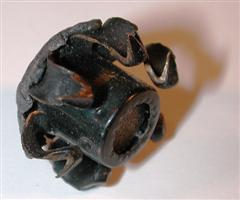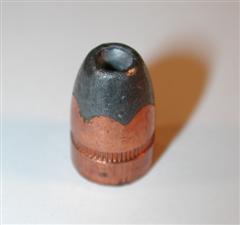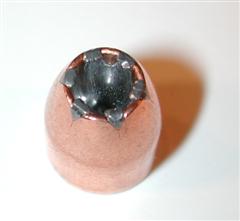Bullet Basics 2- Shapes
(Back)
 The shape of a bullet dictates the aerodynamic and impact
characteristics of the bullet. Manufacturers always seem to be tinkering
with the shape of bullets. They are trying to find the right
combination of materials and shape to make the perfect bullet. The shape of a bullet dictates the aerodynamic and impact
characteristics of the bullet. Manufacturers always seem to be tinkering
with the shape of bullets. They are trying to find the right
combination of materials and shape to make the perfect bullet.
So what is the perfect bullet? Well good question. The answer is
that it hasn't been made yet!
Most bullet manufacturers will produce a
variety of bullet shapes within one caliber. Let's briefly discuss a few
of them.
Bullet Shapes
All bullets will generally fall into several
distinct shapes. These shapes usually involve variances in nose and base
of the bullet.
The two most common bullets for the longest
time have been the round nosed lead bullet and the
full-metal-jacketed bullet. Common examples of these can be seen
below.


Round Nose Lead and Full-metal-jacketed bullets
These bullets have a solid nose and as a
result they remain fairly intact when they strike soft targets. In a lot
of cases they will pass right through a target when they don't encounter
something significant like bone.
Other common solid nosed bullets can be seen
below.
 |
 |
|
Lead "Wadcutter" bullet |
Lead "Semi-wadcutter" bullet |
Solid nose bullets are commonly used in
target practice and shooting competitions because they are relatively
inexpensive and have decent ballistic characteristics. But that's where
the use of the solid nosed, non-expanding bullet ends.
Because these bullets have a tendency to pass
easily through a target the energy they have left is wasted energy. Let's
not misunderstand the purpose of a bullet when used against a living target.
The sole purpose of the bullet is to kill or incapacitate that living target.
So, wasted energy is not a desirable characteristic of bullets used by law
enforcement or by private citizens for hunting/self-defense.
The big focus today in bullet design is
creating a bullet that has an expanding point. This expansion is needed to
slow down the bullet when it strikes a target. A bullet that expends all
of its energy in a target is more efficient and in turn produces more damage.
Think of the nose of a bullet as being a parachute. When it strikes a
target it is designed to open up expanding its surface area as much as twice the
original diameter of the bullet. This expansion is typically called
"mushrooming" as the bullet takes on a shape similar to a mushroom. See
the example below.


Winchester "Black Talon" bullet
Bullets designed to expand usually have a
hollow cavity formed into the nose of the bullet. These are referred to as
hollow-point bullets. Below are some common hollow-point
bullets.
 |
 |
|
Federal Hyda-Shok bullet
with center post. |
Remington semi-jacketed hollow-point bullet |
But wait just a minute! Bullets can expand
too much if they aren't put together just right or can fail to expand
sufficiently. A bullet that expands too much can break up into smaller
pieces and this fragmentation can limit penetration. This is not necessarily a
bad thing and a bullet designed to fragment is called the Glaser Safety Slug
seen on the previous page. This bullet is designed to break apart
scattering numerous small lead pellets throughout the target. Each of the
small pellets will create it's own wound track and cause an enormous amount of
bleeding. Unfortunately this type of bullet must hit the torso of a body
to be effective.
Sometimes more penetration is desirable.
Take for example shooting at an elephant. If the bullet is designed to
expand rapidly it will not penetrate deeply enough to get the job done.
Bullets that have controlled expansion may have a soft area of lead exposed at
the nose and usually lack the hollow-point cavity. Some examples are
below.
 |
 |
|
Semi-jacketed Soft Point bullet |
Jacketed Soft Point bullet |
Police officers also need a bullet that has
decent penetration characteristics. They need a bullet that can possibly
pass through the windshield of a car or through heavy clothing and still retain
the integrity to strike the target with enough energy to disable the threat.
This is accomplished a lot of times by increasing the velocity, weight, and
hardness of the bullet. A good example of a bullet designed for Law
Enforcement use is the Speer Gold-Dot bullet seen below. This expanding
point bullet uses a copper jacket that is bonded to the lead core to slow down
the expansion of the bullet. When it mushrooms you will see a unique small
copper dot at the center of the hollow-point cavity.


Speer Gold-Dot Jacketed Hollow-point bullet.
The base shape of a bullet can also be an
area firearm examiners will use to help determine the manufacturer of a bullet.
Some bullets have bases that taper in, these are referred to as "Boat-tail"
bullets. Others may have expanded bases or banded bases.
 |
 |
 |
|
Gas-check copper
base lead bullet |
Remington Golden Sabre
expanded base bullet |
7.62x39mm boat-tail bullet |
Well, as you can see there are seemingly
endless of variables when it comes to the characteristics of bullets. I've
only touched primarily on centerfire handgun ammunition in this summary but
rimfire ammunition, and rifle ammunition offer just as many
options and challenges for firearm examiners. Information regarding
shotshell construction can be found
here.
It will always be impossible for firearm
examiners to remember all bullet types. Some are not widely distributed
and new bullet designs come out it seems everyday! But we still try.
It may not seem like a big deal but in a trial the bullet manufacturer or
caliber may end up being a very critical piece of evidence that will help with a
conviction or prove the innocence of a defendant.
Now that you've been introduced to various
bullet types and configurations try your luck at the
Projectile ID Quiz located in the
Resource Section! You should review both this Bullet Basics section and
the Shotshell section prior to taking the test.
Bullet Search Database!
To help examiners narrow down the possible
caliber or manufacturer of an unknown bullet we have created a searchable
database of over 1100 known bullet types. Click the link below to go
searching!

Back
|